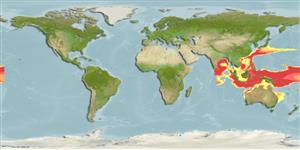Classification / Names
Common names | Synonyms | Catalog of Fishes(genus, species) | ITIS | CoL | WoRMS | Cloffa
Teleostei (teleosts) >
Stomiiformes (Lightfishes and dragonfishes) >
Stomiidae (Barbeled dragonfishes) > Melanostomiinae
Etymology: Eustomias: Greek, eu = good + Greek, stoma = mouth (Ref. 45335); perplexus: From its perplexing combination of characteristics also found in longibarba and curtatus.
Environment: milieu / climate zone / depth range / distribution range
Ecology
Marine; pelagic-oceanic; depth range 0 - 2600 m (Ref. 11333). Tropical
Western Pacific: China and Papua New Guinea.
Size / Weight / Age
Maturity: Lm ? range ? - ? cm
Max length : 13.4 cm SL male/unsexed; (Ref. 11333); 14.7 cm SL (female)
Dorsal soft rays (total): 24; Anal soft rays: 35; Vertebrae: 67. A single terminal bulb, its length more than twice its width, with a terminal projection that may be undeveloped or up to 55% of bulb length. Bulb and projection combined 0.8-2.2% SL. Barbel 67-83% SL, except in the smallest specimen. Axis of stem moderately to fairly dark pigmented proximally, becoming lighter or unpigmented distally. External chevron-shaped or roundish striated areas unpigmented, becoming closely spaced distally. Widely spaced spherical inclusions present in distal 1/3 to 1/2 of stem, sparse or absent before bulb. Middorsal paired spots between occiput and dorsal-fin origin 8, sometimes 9 (Ref. 11333).
Life cycle and mating behavior
Maturity | Reproduction | Spawning | Eggs | Fecundity | Larvae
Kailola, P.J., 1987. The fishes of Papua New Guinea. A revised and annotated checklist. Vol. 1. Myxinidae to Synbranchidae. Research Bulletin No. 41. Department of Fisheries and Marine Resources, Port Moresby, Papua New Guinea. 194 p. (Ref. 6993)
IUCN Red List Status (Ref. 130435: Version 2024-1)
Threat to humans
Harmless
Human uses
Fisheries: of no interest
Tools
Can't connect to MySQL database fbquizv2. Errorcode: Too many connections
